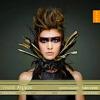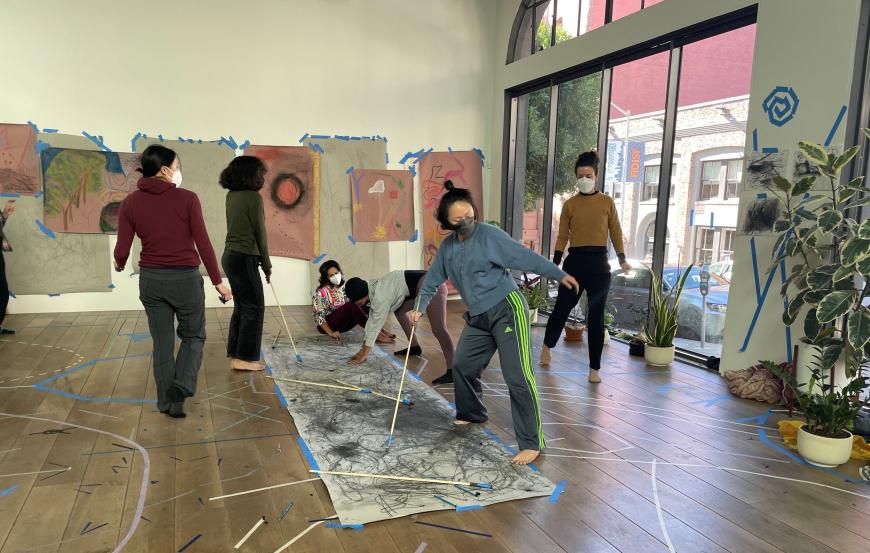
Ensemble for Nonlinear Time, a new collaborative multidisciplinary work between choreographer Hope Mohr and artist Ranu Mukherjee at Gallery 836M in San Francisco, could not be timelier. Initially developed and workshopped during the pandemic at ARTogether in Oakland, with immigrant and refugee artists, this project expresses emotional responses and interactions to rupture in a real and imaginary world, past and present, through movement interacting with art. Mohr and Mukherjee’s three-month residency at 836M will culminate with two free public performances on Wednesday, April 27, and Thursday, April 28.
Céline Ricci, who recently took over the role of programming director at Gallery 836M, just 15 days after the project started, says she has really enjoyed watching the project unfold. An acclaimed soprano and the founder of Ars Minerva, Ricci has a special appreciation for what the duo are creating.
“I am really thrilled and feel very fortunate to be around residencies where artists can develop their work,” said Ricci. “I know what it means to have to put everything together, and I think this is a great opportunity for the artists. I am very grateful to our founders for deciding to do this project.”
I recently spoke with Mukherjee and Mohr about their three-month residency at Gallery 836M — what they have created and what their experience has been like.
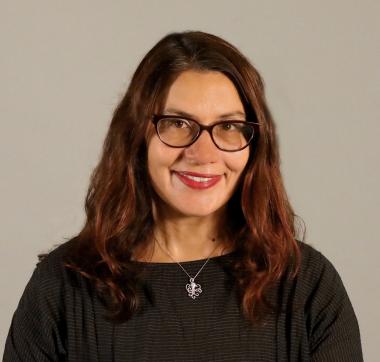
What does the title Ensemble for Nonlinear Time refer to?
Mukherjee: In a certain way, it’s quite literal. It’s about how time works when it’s imagined as something that moves not only back and forth but also in multiple ways and in multiple registers at the same time. That’s a really important idea, so we are working with different time signatures in the choreography. The dancers are working with some rhythms that come from extinct birds, thinking about how the extinct birds can speak in the moment. Those birds appear in my paintings and in Hope’s archived recordings of them.
Is there any particular storyline or theme to the project?
Mohr: Rupture is the context for the project because what we’re doing takes rupture as a starting point, as a beginning, rather than an ending, so all of the work that we’re doing in terms of imagining the future comes from a place of rupture. It’s a very hopeful project because it is saying, okay, rupture is where we begin, where we start, and let’s take what we’ve learned and the expertise that we’ve gleaned from that experience and imagine a future.
Mukherjee: A lot of the content of this residency has been about imagining that we’re in a forest. Each person has a different forest in their mind, so a lot of it is about how we internalize nature and how it internalizes us. The forest came from an exercise I did a while ago about imagining your dreamworld in four years, without any practical limitations. I thought about this forest first as an urban space that took the place of boulevards as a teaching space, a healing space, and a space for interspecies communication.
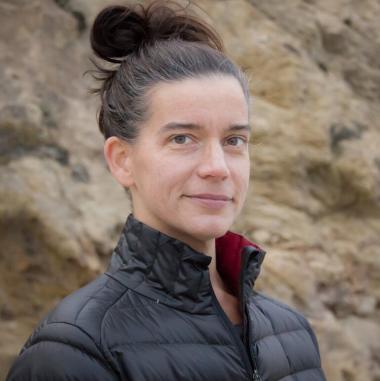
Mohr: To add to the metaphor of the forest, it’s not a space that’s isolated from urban life or from politics. It’s been great to feel like we’re in a creative process that’s anchored in this imaginary forest but also very much in the city. It’s been a really great combination.
There is so much rupture going on the world. Do you feel like this project also embraces what’s going on now?
Mukherjee: We have been working on this for a long time, so we were thinking about rupture as a prompt before COVID, and then suddenly — we’re all in it.
What kind of imagery have you used?
Mukherjee: Right now, in the space we have two pieces of my work that have been inspirations, catalysts, or totems. One of them is a painting that has the birds in it, called Nocturne, which is in my imaginary forest. And there’s a video called Dead in the Wild, which is playing on a monitor that involves the extinct bird image. It all moves in the same direction, so it has informed some of the dancers’ movements. Like rupture, it becomes, and then it breaks apart, over and over again.
Mohr: The image of the painting appears in the choreography, and the birds themselves also inspired bits of choreography, postures and gestures that the dancers move through.
Will there be music?
Mohr: We are working with a sound designer and the soundscape is going to be a real collage. There will be bits of music in it and lots of different textures and some of the birdsong, plus some ambient sound.
How do you two work on this together?
Mukherjee: We’re collaborating on all of it. We have a very fixed schedule for the rehearsals, and we plan each day together. We take different roles at different times of the day, so it’s a real merging of practices. This particular project is more movement oriented, so the visual art part of it is like a catalyst for the movement. Hope takes the lead when it comes to the granularity of the choreography and directing the dancers, which is something I’ve been really enjoying being in the room with.
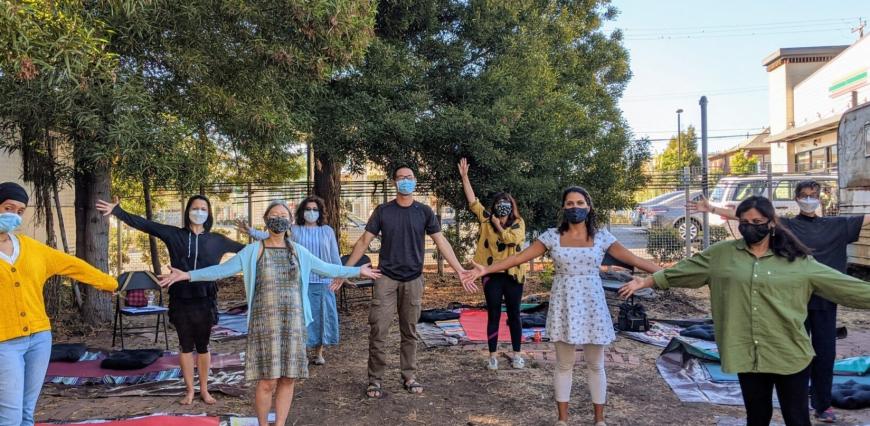
What has it been like being in residence at Gallery 836M?
Mohr: It has been really amazing. It’s a three-month project, which is a real gift because it’s not that we just show up and offer a show, we are able to be in process, and that is really unusual in the arts. And the fact that Ranu and I can spend this much intensive time together in process is also a tremendous gift.
Mukherjee: The work wouldn’t exist in this form without being able to spend this much time in process to develop something. And it’s kind of a dream to be there ... in a light-filled spaced with a wood floor. It’s just an amazing environment.
Do you think you will you be collaborating together in the future?
Mohr: We see this residency as a window into a longer-term project that started with those workshops, and I don’t know when it will end.



